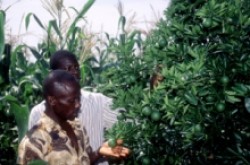Forests, potential solution in the fight against hunger
Forests, potential solution in the fight against hunger. More attention to forest foods and services can improve food security in poor nations
26 October 2011, Rome
The role of forests in providing timber and other wood products must not overshadow their important contribution to feeding many of the world’s poorest communities, a group of international forest organizations and secretariats said today.

According to the Collaborative Partnership on Forests (CPF), of which FAO is an active member, forests can play an even greater role in feeding the world and helping farmers cope with climate change, but their potential to do so is not being fully realized.
With nearly one billion people in the world suffering from chronic hunger, the CPF said the potential of forests and trees to improve food and nutritional security needs more attention from national and regional policymakers and international development agencies.
“Forests and trees on farms are a direct source of food and cash income for more than a billion of the world’s poorest people,” said FAO Assistant Director-General for Forestry Eduardo Rojas-Briales. “They provide both staple foods and supplemental foods. To enhance these benefits, governments and development partners should increase investments in support of sustainable forest management and rehabilitation of degraded forest lands.”
Rojas noted that in India, more than 50 million people depend directly on forests for subsistence, while in the Lao People’s Democratic Republic, wild foods are consumed by 80 percent of population on a daily basis.
Nutritional values of forest flora substantial
Forest foods and wild animals form a small but critical contribution to otherwise bland and nutritionally poor diets of rural people. For instance, wild leaves can be an excellent source of vitamins A and C, protein and micronutrients such as calcium and iron. Fruits are especially good sources of minerals and vitamins and contribute significant quantities of calories. A variety of forest plants have edible roots and tubers, which provide carbohydrates and some minerals.
However, forest-dependent wildlife and forest foods are increasingly threatened by overexploitation in many developing countries, causing biodiversity loss and putting food security at risk. The Convention on Biological Diversity (CBD) and the Center for International Forestry Research (CIFOR), at a meeting in November 2011, will discuss new measures for improving the sustainable management of wildlife in tropical and sub-tropical countries.
Women also play an important part in the processing of tree and forest products, the income from which helps their families achieve food security. For instance, women use shea as a cooking fat and food accompaniment in West Africa. The harvesting and processing of shea, which is an important ingredient in chocolate and other confectionery, provides rural women with nearly 80 percent of their income.
Emmanuel Ze Meka, Executive Director of the International Tropical Timber Organization, noted, “food products are the fastest growing component of non-timber forest products in many tropical countries. And adding value to the forest makes it more likely to remain forest rather than converted to other uses.”
Agroforestry can double yields for smallholder farmers
Agroforestry combines working trees with crop or livestock production and holds great promise for smallholder farmers. These trees are part of the cycle of productivity on farms and provide numerous products, including food for humans and fodder for livestock.
“Agroforestry provides a climate smart agriculture alternative that can increase food production and improve farmers’ incomes and living standards,” said Tony Simons, Director General of the World Agroforestry Center (ICRAF). “Agroforestry can both mitigate climate change by storing carbon as well as helping farmers become resilient and adapt to unpredictable seasons.”
Over 400,000 farmers in Malawi, Tanzania, Mozambique, Zambia and Zimbabwe who practice farming that integrates fertilizer tree systems, have seen food production yields doubled. The World Agroforestry Center plans to scale-up similar programs across Africa and South Asia.
Forests support the agriculture sector
In addition to forests’ direct contribution to rural diets, forests also provide environmental services that support sustainable agricultural production – which are hugely valuable but cannot be measured easily.
“While some observers have posed increased forest protection and increased agricultural production as a zero-sum trade-off, in fact forests provide many environmental services — such as those related to pollination, hydrological, and climate moderation — that sustain agricultural productivity,” said Frances Seymour, CIFOR Director General.
###
> UN Food and Agriculture Organization (FAO).
The Food and Agriculture Organization of the United Nations (FAO) is an intergovernmental organization and has 191 Member Nations, two associate members and one member organization, the European Union. Achieving food security for all is at the heart of FAO’s efforts – to make sure people have regular access to enough high-quality food to lead active, healthy lives.

FAO’s mandate is to raise levels of nutrition, improve agricultural productivity, better the lives of rural populations and contribute to the growth of the world economy.
The Food and Agriculture Organization of the United Nations (FAO) is working with its Members and the entire international community for achievement of the Millennium Development Goals.
These eight goals – each with specific targets and indicators – are based on the United Nations Millennium Declaration, signed by world leaders in September 2000. They commit the international community to combating poverty, hunger, disease, illiteracy, environmental degradation, and discrimination against women.
![]()
The eight Millennium Development Goals are:
Goal 1: Eradicate extreme poverty and hunger
Goal 2: Achieve universal primary education
Goal 3: Promote gender equality and empower women
Goal 4: Reduce child mortality
Goal 5: Improve maternal health
Goal 6: Combat HIV/AIDS, malaria and other diseases
Goal 7: Ensure environmental sustainability
Goal 8: Develop a Global Partnership for Development
* More information at UN Food and Agriculture Organization (FAO)
###
###
> United Nations (UN).
 The United Nations was established on 24 October 1945 by 51 countries committed to preserving peace through international cooperation and collective security. Today, nearly every nation in the world belongs to the UN: membership totals 192 countries.
The United Nations was established on 24 October 1945 by 51 countries committed to preserving peace through international cooperation and collective security. Today, nearly every nation in the world belongs to the UN: membership totals 192 countries.
When States become Members of the United Nations, they agree to accept the obligations of the UN Charter, an international treaty that sets out basic principles of international relations. According to the Charter, the UN has four purposes:
- to maintain international peace and security;
- to develop friendly relations among nations;
- to cooperate in solving international problems and in promoting respect for human rights;
- and to be a centre for harmonizing the actions of nations.
###
* The above story is adapted from materials provided by United Nations (UN)
** More information at United Nations (UN)



















